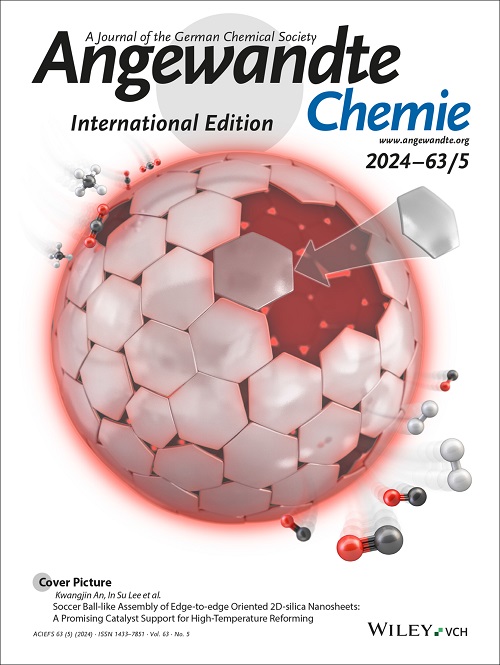原子碘在氧还原反应中对 Fe-N4 位点的轴向配位效应的分子证据
IF 16.1
1区 化学
Q1 CHEMISTRY, MULTIDISCIPLINARY
引用次数: 0
摘要
我们通过电化学扫描隧道显微镜(ECSTM)对氧还原反应(ORR)中原子碘在 Fe-N4 位点上的轴向配位效应进行了分子尺度的研究。通过铁(II)酞菁(FePc)在 I 修饰的 Au(111)表面上的自组装,轻松构建了一个定义明确的模型催化体系,该体系具有明确而均匀的碘配位 Fe-N4 位点。轴向碘配体极大地增强了 FePc 的 ORR 电催化活性。轴向碘巧妙地调节了铁位点的电子结构,从而唤起了更高的自旋构型。此外,由于碘配体的存在,活性氧与活性中心之间的相互作用强度变弱,反应在热力学上更为有利。此外,通过原位 ECSTM 电位脉冲实验,明确测定了 I/Au(111) 上 FePc 的促进反应动力学。值得注意的是,轴向原子碘对提高 Co-N4 位点的活性没有作用,也没有检测到电子重排,这表明轴向配体与金属位点之间为优化电子结构和催化行为而进行的充分相互作用是轴向配体发挥重要作用的先决条件。本文章由计算机程序翻译,如有差异,请以英文原文为准。
Molecular Evidence for the Axial Coordination Effect of Atomic Iodine on Fe-N4 Sites in Oxygen Reduction Reaction
We present a molecular-scale investigation of the axial coordination effect of atomic iodine on Fe-N4 sites in the oxygen reduction reaction (ORR) by electrochemical scanning tunneling microscopy (ECSTM). A well-defined model catalytic system with explicit and uniform iodine-coordinated Fe-N4 sites was constructed facilely by the self-assembly of iron(II) phthalocyanine (FePc) on an I-modified Au(111) surface. The electrocatalytic activity of FePc for the ORR shows a tremendous enhancement with axial iodine ligands. The ingenious modulation of the electronic structure of Fe sites to evoke a higher spin configuration by axial iodine was evidenced. In addition, the interaction strength between reactive oxygen species and active centers becomes weaker due to the presence of iodine ligands, and the reaction is thermodynamically preferable. Moreover, the facilitated reaction dynamics of FePc on I/Au(111) were explicitly determined via in-situ ECSTM potential pulse experiments. Noteworthily, axial atomic iodine was found inefficacious for improving the activity of Co-N4 sites, and electron rearrangement was not detected, demonstrating that adequate interactions between axial ligands and metal sites for optimizing electronic structures and catalytic behaviors are prerequisites for the impactful role of axial ligands.
求助全文
通过发布文献求助,成功后即可免费获取论文全文。
去求助
来源期刊
CiteScore
26.60
自引率
6.60%
发文量
3549
审稿时长
1.5 months
期刊介绍:
Angewandte Chemie, a journal of the German Chemical Society (GDCh), maintains a leading position among scholarly journals in general chemistry with an impressive Impact Factor of 16.6 (2022 Journal Citation Reports, Clarivate, 2023). Published weekly in a reader-friendly format, it features new articles almost every day. Established in 1887, Angewandte Chemie is a prominent chemistry journal, offering a dynamic blend of Review-type articles, Highlights, Communications, and Research Articles on a weekly basis, making it unique in the field.

 求助内容:
求助内容: 应助结果提醒方式:
应助结果提醒方式:


